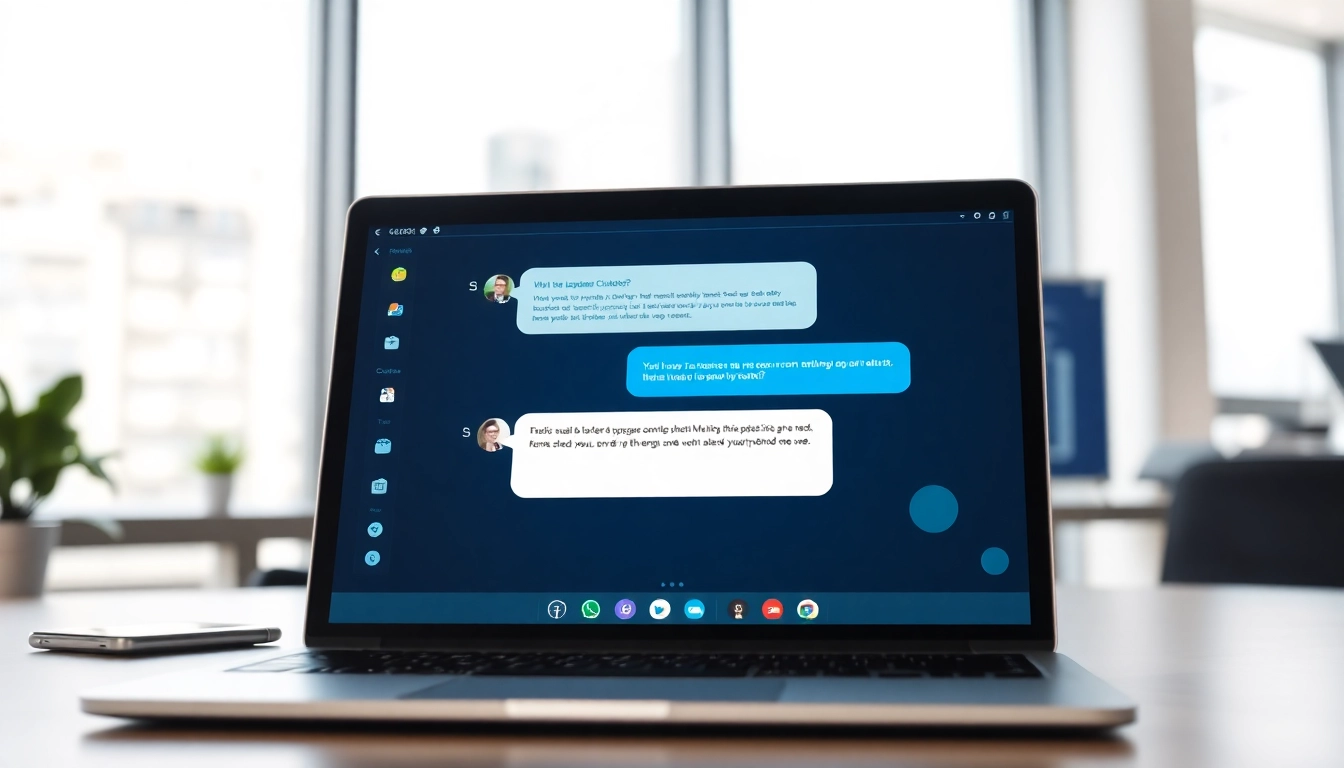
Understanding AI Chat Bots
What is an AI Chat Bot?
An AI chat bot is a sophisticated software application designed to simulate human conversation through auditory or text-based means. These chat bots leverage artificial intelligence (AI) and machine learning technologies to interact with users in a manner that feels natural and engaging. With the ability to understand languages, recognize context, and provide responses based on data, AI chat bots are quickly becoming integral to how businesses manage customer interactions. They operate from preset scripts and advanced algorithms to enhance user experience while being flexible enough to adapt based on user input.
How AI Chat Bots Work
The technology behind AI chat bots often involves natural language processing (NLP), which allows the bots to comprehend and interpret human language. At the core of this functionality are a series of steps that include:
- User Input: The conversation initiates with a user’s query either via text or speech.
- Understanding Intent: The AI employs NLP to determine the intent of the user’s input.
- Response Generation: Based on the interpreted intent, the bot generates an appropriate response using preset data or dynamic algorithms.
- Feedback Loop: Many advanced chat bots learn from past interactions, allowing them to improve over time.
Moreover, advances in machine learning enable chat bots to provide more accurate responses, ultimately enhancing user satisfaction.
Benefits of Using AI Chat Bots
Implementing AI chat bots can yield numerous benefits for businesses, including:
- 24/7 Availability: AI chat bots allow businesses to offer round-the-clock customer service, reducing response times and improving customer satisfaction.
- Cost Efficiency: By automating routine inquiries, businesses can significantly reduce staffing costs while maintaining service quality.
- Scalability: During peak times, chat bots can manage thousands of conversations simultaneously, something human agents can’t achieve.
- Data Collection: Chat bots gather valuable data about customer preferences and behavior, facilitating better-targeted marketing strategies.
Beyond enhancing operational efficiency, ai chat bots foster improved engagement, which can lead to heightened brand loyalty and increased sales.
Implementing AI Chat Bots in Your Business
Choosing the Right AI Chat Bot for Your Needs
Selecting the appropriate AI chat bot for your business involves several considerations:
- Business Goals: Define what you want to achieve with a chat bot—be it improved customer service, increased sales, or lead generation.
- Integration Capability: Ensure the chat bot can be integrated seamlessly with your existing systems, such as CRM software and other platforms.
- Customization Options: Look for chat bots that allow customization to fit your brand voice and customer needs.
- Support and Maintenance: Opt for solutions that provide robust support, regular updates, and easy maintenance.
Step-by-Step Guide to Integration
Integrating an AI chat bot into your business can be streamlined by following these steps:
- Assessment of Needs: Clearly define the functions you need from the chat bot and identify existing pain points in customer interactions.
- Choosing the Right Solution: Based on your assessment, choose an AI chat bot that meets your specific criteria.
- Developing a Conversation Flow: Map out potential interactions and develop conversation flows to ensure a smooth user experience.
- Testing: Before a full rollout, conduct extensive testing with internal teams to ensure accuracy and efficiency.
- Launch and Monitor: Deploy the chat bot and monitor performance metrics and user feedback closely to make necessary adjustments.
Common Challenges and Solutions
Implementing AI chat bots might come with its challenges. Here are some common hurdles and their solutions:
- Handling Complex Queries: Bots may struggle with intricate questions. Solution: Implement a hybrid model where complex inquiries are escalated to human agents.
- Maintaining Engagement: Users might find interactions lackluster. Solution: Personalize conversations using customer data and preferences.
- Integration Issues: Technical difficulties can arise during integration. Solution: Work with a proven provider that offers comprehensive integration support.
- Ensuring Accuracy: Misunderstandings can occur if bots misinterpret intentions. Solution: Regularly train bots using data from past interactions to enhance their responses.
Optimizing Performance of AI Chat Bots
Key Metrics to Monitor Success
To ensure the success of your AI chat bot, it’s essential to track various metrics, such as:
- Response Time: Measure the time taken from a user’s input to the bot’s response.
- User Satisfaction Scores: Collect feedback to gauge how well the chat bot is meeting customer needs.
- Conversation Completion Rate: Monitor how many conversations successfully resolve the user’s queries.
- Return on Investment (ROI): Analyze cost savings and revenue generated as a result of implementing the chat bot.
Enhancing User Experience with AI Chat Bots
Improving user experience is paramount to the effectiveness of AI chat bots. Here are some strategies:
- Personalization: Utilize user data to tailor conversations, making interactions feel more customized and engaging.
- Continuous Learning: Employ machine learning to refine chat bot responses based on previous interactions.
- Proactive Engagement: Programmable prompts that reach out to users for assistance can create more engaging experiences.
- Multi-Channel Support: Ensure chat bots can communicate across various platforms, be it social media, websites, or messaging apps.
Continuous Improvement Strategies
To maximize the effectiveness of your AI chat bot over time, consider these continuous improvement strategies:
- Regular Updates: Routinely update the chat bot’s database with new information to keep responses relevant.
- User Training: Provide training to users on how best to interact with the bot for optimal results.
- Feedback Loops: Integrate feedback mechanisms that allow users to rate their experience, facilitating ongoing enhancements.
- Analyzing User Behavior: Review logs of user interactions to identify common issues and implement corrections as needed.
Real-World Examples of Successful AI Chat Bot Applications
Case Study 1: Retail Industry
A popular retail chain integrated an AI chat bot on its e-commerce platform, enabling customers to ask questions about product availability, sizes, and prices. Over the course of three months, they observed a 30% decrease in customer inquiries to their support team and a 10% increase in conversion rates due to the immediate assistance provided by the bot.
Case Study 2: Healthcare Sector
A healthcare provider developed a chat bot to alleviate patient queries regarding appointments and general health advice. The implementation resulted in a 40% reduction in call volume to the reception desk, enabling staff to focus on in-person patients. Patient satisfaction scores improved significantly, with many users noting the convenience of having health information at their fingertips.
Case Study 3: E-commerce
An e-commerce site employed an AI chat bot to assist customers with order tracking and managing returns. The bot managed more than 60% of all customer interactions, leading to faster response times and more satisfied customers. The company reported a significant reduction in cart abandonment rates as users could quickly resolve issues that frequently caused hesitations during checkout.
The Future of AI Chat Bots in Customer Engagement
Emerging Trends in AI Technology
The future of AI chat bots is promising, with emerging trends such as:
- Emotional Intelligence: Future chat bots may incorporate emotional AI to recognize user emotions and adjust responses accordingly.
- Voice Interaction: Voice-activated chat bots will likely become more prevalent, allowing for a hands-free user experience.
- Enhanced Personalization: Deeper integration of AI analytics will enable even more targeted and relevant interactions.
Ethical Considerations in AI Usage
As organizations adopt AI chat bots, ethical considerations are paramount. These include:
- Data Privacy: Protecting user data is essential; businesses must comply with data protection regulations.
- Transparency: Users should be made aware that they are interacting with a bot and not a human.
- Bias Mitigation: Developing and training algorithms that minimize bias is crucial to ensure fair interactions.
Preparing for Changes in Customer Expectations
As AI chat bots become more prevalent, customer expectations will shift. Organizations should be prepared to:
- Enhance User Experience: Focus on continuously refining bot interactions based on customer feedback.
- Stay Current: Keep pace with advancements in AI technology to offer cutting-edge solutions.
- Adapt to User Preferences: Regularly analyze user data to adjust strategies as preferences evolve.





